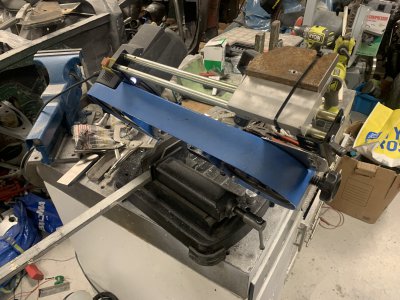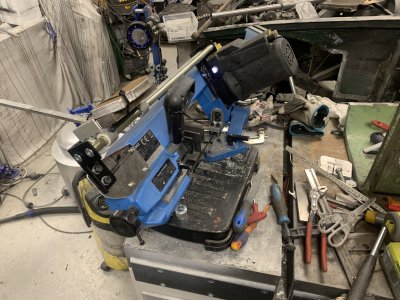- Joined
- Sep 28, 2013
- Messages
- 4,319
I think it does help to run the two guides as close together as the stock allows, as the sharp twist from the wheel to guide isn't good for band life



I have sorted out both wheels,made new shafts and still they break and not always on the weld. I did notice a while back when a blade broke,that there was numerous cracks on the blade. It was then I think that I mentioned it here on H-M,and it was one of our members that said maybe I am over tentioning the blade. So I eased up on the tension. On the blade that broke yesterday, it broke on the weld, but no cracks. I must stand up for the company that supply my blades,they are a very reputable company around here.I understand what you were told, but I just can't agree. My money is on one of the wheels if not both is/are cocked. Broken blades were improperly annealed welds or too much material being ground off when smoothing the weld joint. Possibly FPM is too fast
I think it does help to run the two guides as close together as the stock allows, as the sharp twist from the wheel to guide isn't good for band life
E.M.T. always bites back. Sometimes I just use a hacksaw on 1/2" or 3/4" or tubing cutter.I would have to answer "it depends".
Sometimes I have risked it and lost teeth when cutting thin-wall tubing with a coarse blade, those breaks are 100% on me.
The breaks and skips that annoy me are when I have way more than 3 teeth engaged and things are still going haywire.
I added a sliding weight yesterday so I can experiment with a more consistent cutting pressure.
The weight is just enough to make the saw fall down when placed halfway out from the motor so it's not heavy, at that position it will pretty much not cut at all in steel.
Having the weight "too far out" I've noticed a tendency for it to start cutting unevenly after a bit, it's like the cutting pressure builds up and the frame is struggling more and more.
Looking at it, it's a lot like self-reinforcing harmonics.
This could explain why the blade "suddenly" goes flying as the oscillations gets too bad.
If this happened I could move the weight back a bit and it'd stop so I will try this setting and see if it works, even tho it's cutting horribly slow.
Doesn't matter too much now that I don't need to hold my hand on the trigger.
View attachment 435936View attachment 435937
I understand and admire your'e loyalty, but I think you should try another supplier for blades and go from there. Thanks, Charlie.I have sorted out both wheels,made new shafts and still they break and not always on the weld. I did notice a while back when a blade broke,that there was numerous cracks on the blade. It was then I think that I mentioned it here on H-M,and it was one of our members that said maybe I am over tentioning the blade. So I eased up on the tension. On the blade that broke yesterday, it broke on the weld, but no cracks. I must stand up for the company that supply my blades,they are a very reputable company around here.
Easier said than done. The closest supplier is about 70km away. This one is 14km away and the owner lives in my town so he is so decent to bring my blades to my home. But I get that I must consider other sorces.I understand and admire your'e loyalty, but I think you should try another supplier for blades and go from there. Thanks, Charlie.
That's a lot of weight on the blade. As someone else mentioned I would bring the guide in to reduce the span.I would have to answer "it depends".
Sometimes I have risked it and lost teeth when cutting thin-wall tubing with a coarse blade, those breaks are 100% on me.
The breaks and skips that annoy me are when I have way more than 3 teeth engaged and things are still going haywire.
I added a sliding weight yesterday so I can experiment with a more consistent cutting pressure.
The weight is just enough to make the saw fall down when placed halfway out from the motor so it's not heavy, at that position it will pretty much not cut at all in steel.
Having the weight "too far out" I've noticed a tendency for it to start cutting unevenly after a bit, it's like the cutting pressure builds up and the frame is struggling more and more.
Looking at it, it's a lot like self-reinforcing harmonics.
This could explain why the blade "suddenly" goes flying as the oscillations gets too bad.
If this happened I could move the weight back a bit and it'd stop so I will try this setting and see if it works, even tho it's cutting horribly slow.
Doesn't matter too much now that I don't need to hold my hand on the trigger.
View attachment 435936View attachment 435937
